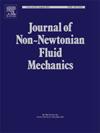非牛顿流体在轴向变化毛细血管中的渗透动力学
IF 2.8
2区 工程技术
Q2 MECHANICS
引用次数: 0
摘要
非牛顿流体在不规则壁毛细血管中的毛细管驱动渗透在工业应用中至关重要,例如铝生产的阳极制造,其中煤焦油沥青和细石油焦颗粒(粘结剂基质)的混合物浸渍在粗焦颗粒的开放孔隙中。我们的研究提出了一个半解析模型,用于毛细管驱动的剪切变薄流体在轴向变化的波壁微通道中流动,代表了焦炭的开孔几何形状。结合弱惯性、粘性耗散和动态接触角行为(由分子动力学理论控制),利用润滑理论和幂律流变学系统地推导了该模型,得出了推进半月板的降阶方程。通过计算流体动力学仿真对模型进行了验证和标定,提取了动态接触角校正参数。我们的分析量化了三种不同的渗透机制及其过渡动力学:惯性主导、界面耗散主导和粘性耗散主导。解析标度定律和制度转换相关性在不同的幂律指数、拉普拉斯数、接触角和几何特征中得到验证。幂律指数对渗透的影响最大,其次是静态接触角和几何相移,而拉普拉斯数对早期行为的影响最大。动态接触角分析强调了界面耗散在不规则几何结构中的关键作用。将该模型应用于流变学测量的粘结剂基体,结果表明,增加细焦含量或沟道不平整会显著延迟浸渍。本文章由计算机程序翻译,如有差异,请以英文原文为准。
Penetration dynamics of non-Newtonian fluids into axially varying capillaries
The capillary-driven penetration of non-Newtonian fluids in capillaries with irregular walls is crucial in industrial applications, such as anode manufacturing for aluminum production, where a mixture of coal-tar pitch and fine petroleum coke particles (binder matrix) impregnates the open pores of coarse coke particles. Our study presents a semi-analytical model for capillary-driven flow of shear-thinning fluids in axially varying, wavy-walled microchannels, representative of coke open pore geometries. Incorporating weak inertia, viscous dissipation, and dynamic contact angle behavior (governed by a molecular kinetic theory), the model is systematically derived using lubrication theory and a power-law rheology, yielding a reduced-order equation for the advancing meniscus. The model is validated and calibrated via computational fluid dynamics simulations to extract the dynamic contact angle correction parameter. Our analysis quantifies three distinct penetration regimes and their transition dynamics: inertia-dominated, interfacial dissipation-dominated, and viscous dissipation-dominated. Analytical scaling laws and regime transition correlations are validated across varying power-law indices, Laplace numbers, contact angles, and geometrical features. The power-law index most strongly influences penetration, followed by static contact angle and geometric phase shift, while Laplace number affects early-time behavior. Dynamic contact angle analysis highlights the critical role of interfacial dissipation in irregular geometries. Applied to binder matrices with measured rheology, the model shows that increased fine coke content or channel irregularity significantly delays impregnation.
求助全文
通过发布文献求助,成功后即可免费获取论文全文。
去求助
来源期刊
CiteScore
5.00
自引率
19.40%
发文量
109
审稿时长
61 days
期刊介绍:
The Journal of Non-Newtonian Fluid Mechanics publishes research on flowing soft matter systems. Submissions in all areas of flowing complex fluids are welcomed, including polymer melts and solutions, suspensions, colloids, surfactant solutions, biological fluids, gels, liquid crystals and granular materials. Flow problems relevant to microfluidics, lab-on-a-chip, nanofluidics, biological flows, geophysical flows, industrial processes and other applications are of interest.
Subjects considered suitable for the journal include the following (not necessarily in order of importance):
Theoretical, computational and experimental studies of naturally or technologically relevant flow problems where the non-Newtonian nature of the fluid is important in determining the character of the flow. We seek in particular studies that lend mechanistic insight into flow behavior in complex fluids or highlight flow phenomena unique to complex fluids. Examples include
Instabilities, unsteady and turbulent or chaotic flow characteristics in non-Newtonian fluids,
Multiphase flows involving complex fluids,
Problems involving transport phenomena such as heat and mass transfer and mixing, to the extent that the non-Newtonian flow behavior is central to the transport phenomena,
Novel flow situations that suggest the need for further theoretical study,
Practical situations of flow that are in need of systematic theoretical and experimental research. Such issues and developments commonly arise, for example, in the polymer processing, petroleum, pharmaceutical, biomedical and consumer product industries.

 求助内容:
求助内容: 应助结果提醒方式:
应助结果提醒方式:


